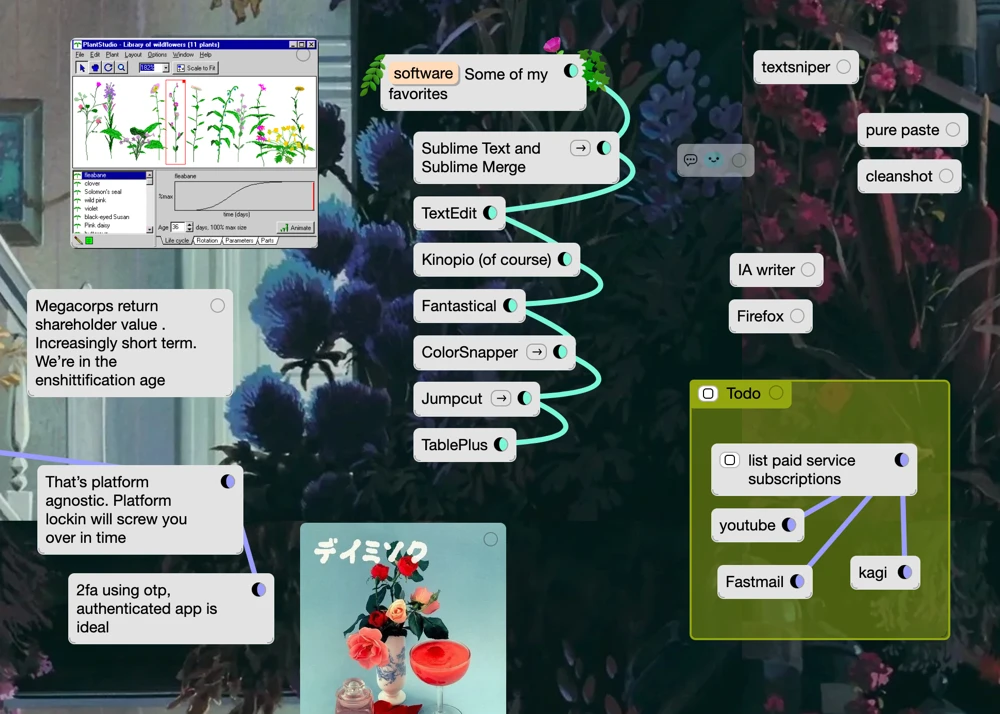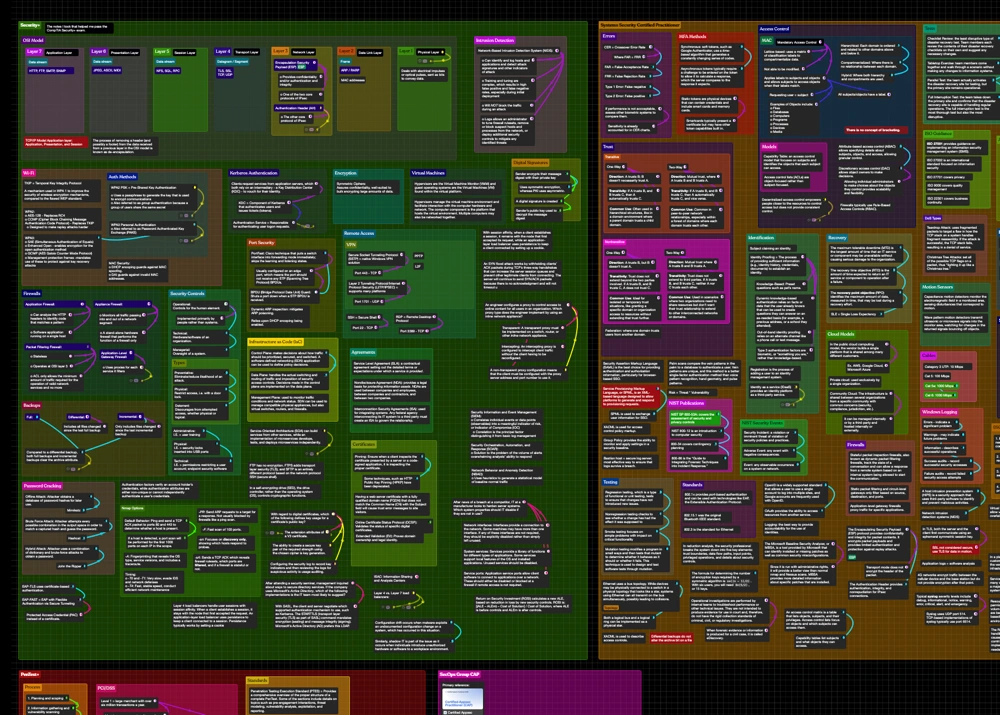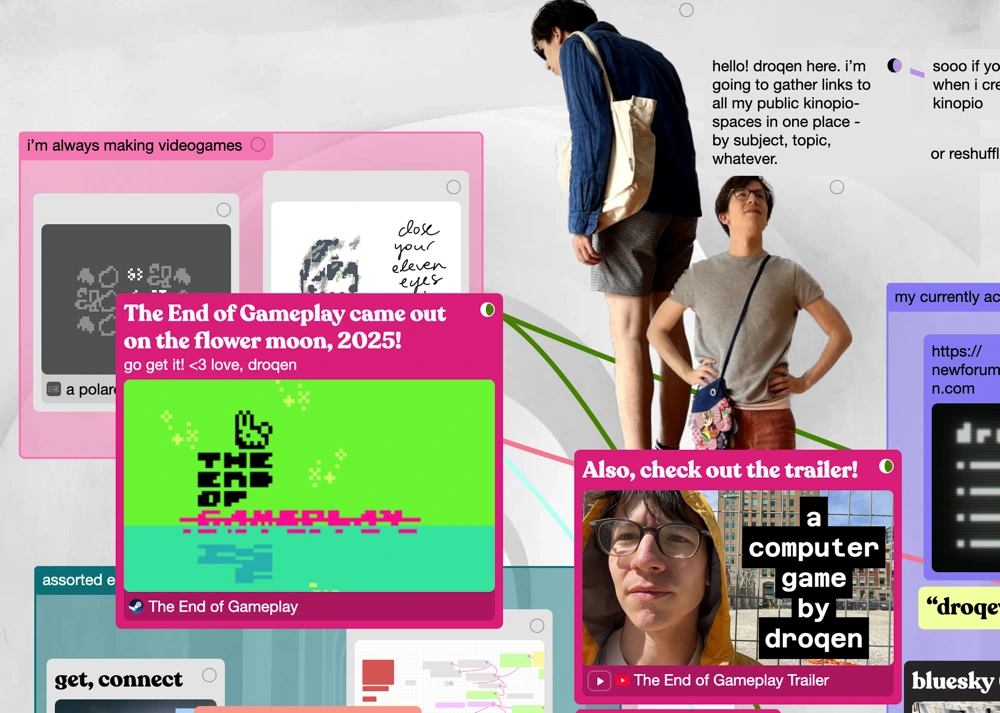Kinopio
Kinopio is a spatial note-taking tool for collecting and connecting your thoughts, ideas, and feelings. Designed to work the way your mind works.
Free for 100 cards. No sign up required.
Create Lively Freeform Spaces

Gather notes, and connect them to their source URLs. Drag in files, like PDFs, to keep everything together. Label concepts with backlinked [[tags]].
Invite friends and group members to collaborate together in real-time.
Featuring ● Real-Time Collaboration ● Privacy Settings ● Code Blocks and Markdown ● Comments ● Card Frames ● Backlinked [[Tags]] ● Link Between /Spaces ● Works Offline
● Dark Mode ● Add Images, Websites, Pdfs ● Import and Export ● Save as PDF ● Public API ● Organize With Boxes ● Freehand Drawing ● Collaborative Space Groups
● Quick Save to Inbox With Browser Extensions ● Trackable Todos ● Personal Templates ● Snap to Grid ● Other secret features may be available… (don’t tell anyone)
New features are being added all the time in Changelog.
FAQ
Who makes Kinopio
Hi I'm Piri, and I've building Kinopio for 7 years.
I believe in building ethical, economically-sustainable, organic software designed by artists, built by craftspeople, and funded by the people who enjoy it.
If you're curious, I wrote How Kinopio is Made.
Sometimes Lucas helps out too.
How does Kinopio compare to Miro, Milanote, Whimsical, and other whiteboard apps?
Physical whiteboards are so productive because drawing and writing with markers is a naturally messy, chaotic process, which produces novel new ideas and shared understanding.
But the typical software whiteboard is designed around neatness and conformity. Expressiveness and personality is replaced with toolbars and sticky notes in one of 5 designer-approved pastel shades.
From customizable backgrounds, to colors, to embedding youtube videos, Kinopio spaces encourage creativity and experimentation.
Like a physical whiteboard, the outputs produced this way tend to be lower-fidelity and conceptual – ideal for problem solving and consensus building.
The other major difference is that Kinopio is organic software, paid for by the people who use it, rather than by VC investors looking for an easy exit.
| Company | VC Funding |
| Figjam | $1,400,000,000, Series F |
| Miro | $476,300,000, Series C |
| Milanote | $780,000 |
| Mural | $196,600,000, Series C |
| Whimsical | $30,000,000, Series A |
| Kinopio | $0 |
The result? Kinopio is a product that embraces individuality and personality. Made for people, not drones.
To see how this plays out IRL, here's a video by a customer comparing Kinopio vs Milanote.
Why doesn't Kinopio have AI features?
Because Kinopio is solely supported by the people who love it, I have the insane privilege of being able to only add features that fit into the product and truly help its users.
With whiteboarding, mind-mapping, or mood-boarding, the journey of placing ideas and images, making connections, and figuring out what things should be grouped together yourself is vitally important to building up your own spatial memory. This is the magic that makes big ideas easier to recall and reason about.
Why should I use Kinopio for work?
There’s always been this myth that really neat, fun people at home all of a sudden get very dull and boring and serious when they come to work, and it’s simply not true.
– Steve Jobs
Exploring big ideas and tackling hard problems is anything but linear, it's a messy and chaotic process that uses both the creative (R) and analytical (L) sides of your brain.
Using tools that embrace creativity and individuality prevents group-think and encourages collaborators to come up with new ways to solve hard problems. Features like trackable tasks and shared groups help turn brainstorming sessions into actionable project plans.
Kinopio is designed for nimble teams that want to build shared understanding, get projects started faster, be more flexible to change, and work better together.
Can I export my data?
Yes, of course – what you write inside Kinopio belongs only to you. There are export options in a variety of formats, and you can download a backup of all your spaces together.
There is also a public API available.
Who else uses Kinopio?
Over the years, it’s been amazing to hear how people use Kinopio to map out and make sense of their ideas, feelings, and plans. I recently started capturing the nice things people are saying about it on the Community Love Wall.
Used by students, teachers, and researchers, at ● NYU ● The New School (Parsons) ● Yale ● MIT ● Stanford ● Berkeley ● Columbia ● School for Poetic Computation
And by designers, engineers, and PMs, at ● Discord ● Brilliant ● Cisco ● Wikimedia ● Atlassian ● Spotify ● Moving Brands
Kinopio has also been featured in The Verge, App Stacks, and was the ProductHunt #1 Product of the Day.
I hope you enjoy using Kinopio and find it invaluable,

